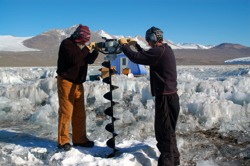GOLF 4-3-9 Antarctica Expedition 2008
Report Day 15 -- Monday 10 November 2008 -- Drilling in Lake Fryxell
GOLF 4-3-9 Antarctica Expedition 2008 |
| Daily Reports 1 | 2 | 3 | 4 | 5 | 8 | 9 | 10 | 13 | 14 | 15 | 16 | 20 | 25 | 27 | 30 | 35 | 37 | 38 | 42 |

Our much-anticipated day of drilling into Lake Fryxell has come. There is a bit of worry and concern because we were warned that drilling can be tricky and that it is very easy to get the Jiffy drill stuck in the ice, in particular in deep holes and in cold ice early in the season. This can happen when the cold ice shavings in the hole mix with the lake water and flash-freeze. This is particularly disastrous when you have a long drill bit that weighs a ton. If the drill bit freezes you donít get a hole until you work for several days to free up the drill bit again. Considering this potential problem we decided not to take any chances and we asked Andrew from Bravo 422 to help us out. He is of similar size as Hubert (at least in terms of height) and he was eager to demonstrate that he was up to the task.

Good thing he helped out because drilling was indeed a challenge. The ice turned out to be much thicker than we were led to believe: Instead of three flights of bits we ended up needing six (five plus a few cm). Each one of these flights weigh ten to fifteen pounds, and the drill another ten pounds. Just holding it up is a significant effort, but moving it up and down to eject the ice shavings is a different story. In the end our rig was over six meters tall and quite heavy. Once we broke through the ice, we sped up the drill so our Auger bit turned into an Archimedesí screw pushing out all remaining ice slush with a big gush of water from the lake. We got our feet wet big time but we had a hole in the ice that was full of water than ice slush. Ready to deploy our mooring. Big "High Five" was in order!
Our mooring is a total of about 18 meters long, with a couple of plastic-coated steel weights at the bottom. Experiments were placed at 14, 11 and 8 meters water depth. We had chosen these water depths because the lake goes through a major transition from high levels of dissolved oxygen at 8 meters to almost no oxygen at 12 meters. Our deployment depths cover the transition between these depths and the high and low oxygen depths. This will help us understand which microbes attack glass under these very different oxygen levels. The only trick with our deployment is that the ice is moving upwards with respect to the chemical zonation of the lake with a rate of about 1 meter per year. Ice continually erodes from the top from wind ablation, and it grows at the bottom by freezing, in particular during the winter.
Our first experiment will have a duration of two years, so we had to make sure that everything can move up about two meters without leaving the environment it is supposed to be in. This is impossible for the transition zone, which is less than two meters thick, but it will work for the others. The transition experiment is still interesting, because it is actually quite common in nature that chemical conditions change, we are moving from a moderately oxygen deprived setting to a more oxygenated setting. Once we were done drilling we laid our mooring out so it would go in flawlessly, and tied it up to a two-by-four to keep it in place while the mooring rope freezes into the ice. Everything is tied to a wooden palette so we can easily find it when we come back in two years. Laurie lowered the mooring into the hole, we set the two-by-four, filled the hole with ice and snow, covered it with a palette and placed a marker-flag, done.
| GOLF 4-3-9 Antarctica Expedition |